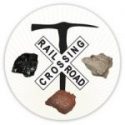I am sometimes asked “How do you install the BMRR signs?” The following is a summary description of that process. If you need additional information about the signs or their installation, contact me through the “Contact Us” page on this website. –James Lowery, Project Coordinator
1. Posts are U-channel, breakaway steel posts. Same type as are used for stop signs, speed limit signs, etc. (That type of post is required for any that are on street or highway right of way.)
2. I get permission of the property owner if the sign will be on private property or permission of the city, county, or state agency if the sign will be on public right-of-way.
3. In most places, a full week prior to the installation, I request 811 to locate, and mark, the underground utilities before I install the post so that I can stay away from any underground utilities.
4. First, I drive a temporary iron rod into the ground about 1.5 to 2 feet to see if I hit concrete or a boulder underground. (If I have hit something underground, I move over a little and try again.) I then remove the iron rod and prepare to install the post at that spot.
5. In some locations, I dig a posthole about 1 to 1.5 feet into the ground if I think there are rocks I need to remove before installing the metal post.
6. Posthole or not, I then drive a 4 to 5 foot steel post (see item number 1) about 2 to 2.5 feet into the ground using a heavy-duty sledge hammer (maul). This is the hardest part of the installation.
7. Using heavy-duty bolts and nuts, I attach a 10 or 12 foot steel post (see item number 1) to the shorter post already driven into the ground.
8. In most cases, I pound (tamp) dirt (or best to use clay soil) tightly around the base of the post at ground level. NOTE: There is NO need to put concrete in the ground around the base of the post — tamped-down clay works just as well. I carry a bucket of clay with me to every install to use for this purpose.
9. I install the aluminum sign using 5/16 inch bolts, nuts, washers, and small plate (to keep the aluminum from warping when tightened-down). NOTE: It is easiest to first install the sign on the 10 or 12 foot post before attaching that post to the one driven into the ground.
10. I take a GPS latitude/longitude reading (such an app is available for cellphones) and a photograph of the installed post and sign for documentation purposes.
11. Back home, I add the sign number and location information to the BMRR website.
12. Ongoing sign maintenance is sometimes required when signs are hit by vehicles or need to be cleaned.
